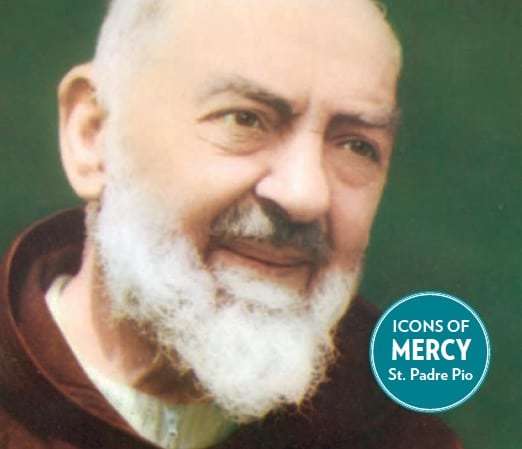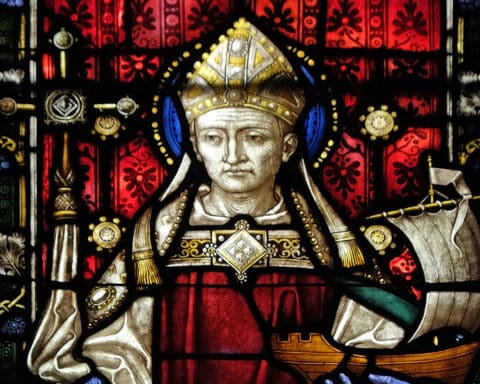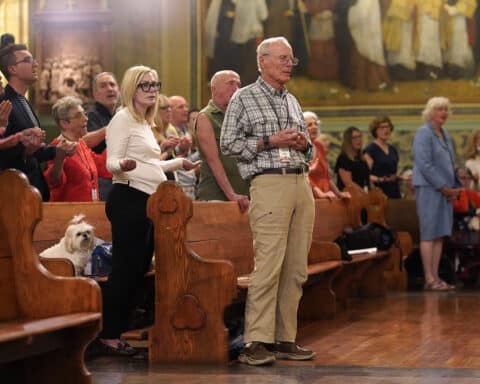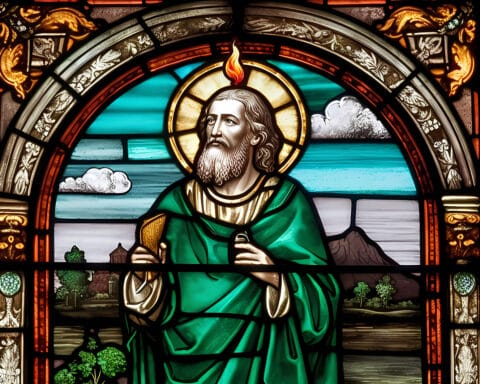In Misericordiae Vultus (“The Face of Mercy”), Pope Francis announced a Jubilee Year of Mercy extending from the feast of the Immaculate Conception on Dec. 8 to the feast of Christ the King on Nov. 20, 2016. In the document, Pope Francis recommends that we consider “the saints and blessed ones who made divine mercy their mission in life” (Misericordiae Vultus, No. 24). By their example, they help us in our own efforts to yield to the same grace.To this end, Our Sunday Visitor will highlight throughout the Jubilee Year of Mercy those who both received and shared God’s mercy in an extraordinary way: 12 “icons of mercy” through whom God reminds us that we are loved and that we have the capacity to love, too, by his grace. Look for a new installation the first Sunday of each month.
St. Padre Pio is a classic icon of mercy.
| A Model of Faith |
|---|
|
St. Padre Pio’s holiness is a shining example for the faithful to follow. With the Italian saint as our model, we can: – Keep faith in times of adversity and illness. Padre Pio’s life was not an easy one. Between serious illness in his younger years, bearing the painful wounds of Christ and being rebuked by his superiors who did not fully understand his gifts, Padre Pio continued to put his trust in God. – Go regularly to confession. Padre Pio was famous for the time he spent in the confessional, and he urged others to seek the sacrament regularly. He is quoted as saying, “Even if a room is closed, it is necessary to dust it after a week. – Pray often. “Prayer is the best weapon we possess,” Padre Pio wrote. “It is the key that opens the heart of God.” During this jubilee year, let us make it a priority to share with God our joys as well as our concerns, which will allow him to show us his mercy in our lives. |
Born Francesco Forgione on May 25, 1887, in Pietrelcina, Italy, St. Padre Pio entered a world rich in prayer and charity. His parents had him baptized the morning following his birthday, and every day after introduced him to new ways of honoring God. His family attended daily Mass, prayed the Rosary every night and abstained from meat three days a week.
Raised in this atmosphere, Padre Pio would cause little surprise when, at the age of 5, he dedicated his life to God. Despite frequent illness and other hardships, Padre Pio continued to focus on his relationship with God. At the young age of 15, on Jan. 6, 1903, he began his life as a Capuchin when he entered the friary at Marcone, which is where he also took the name Pio in honor of Pope St. Pius I.
Seven years of formation for the priesthood followed, all the while still deepening his prayer life and dealing with various ailments.On Aug. 10, 1910, Padre Pio was ordained a priest, but because his health was so precarious, he remained at his family home in Pietrelcina until September 1916, when his condition improved enough that he could travel to San Giovanni Rotondo and live at the Our Lady of Grace Capuchin Friary.
San Giovanni Rotondo has become synonymous with Padre Pio; it remained his home until his death on Sept. 23, 1968. And it was at San Giovanni Rotondo that Padre Pio intensified his desire to give his life to God, precisely as a disciple of Jesus. As Pope St. John Paul II would say during the June 16, 2002, canonization Mass of Padre Pio, the saint “always sought greater conformity with the crucified, since he was very conscious of having been called to collaborate in a special way in the work of redemption.”
Mystical marks
On Sept. 20, 1918, Padre Pio began to experience pain, marks and bleeding in locations on his body that corresponded to the crucifixion wounds of Jesus. It was the first instance of the stigmata that would remain with him until death. Around the same time, he also began manifesting other spiritual gifts like bilocation, the ability to read hearts and even a beautiful fragrance that emitted from his wounds.
Word got out about this priest with the stigmata, and crowds began to swarm the friary at San Giovanni Rotondo. Padre Pio was embarrassed by the attention and wanted — out of a sense of modesty — to hide the stigmata. He asked God to remove the physical wounds without removing the suffering, which Padre Pio would gladly endure out of love for Christ. He would often say that all he wanted was to be a poor Franciscan who prays. The stigmata wounds were not removed, and they began to attract attention from Church authorities worried about scandals.
Several doctors examined the wounds and could not find a rational explanation for their appearance or permanence. They were, and remain, a point of controversy. Graham Greene, the British novelist who attended a Mass at which Padre Pio presided, said that a Vatican official told him, “Pio is a pious old fraud.” Greene didn’t believe it; instead, he confessed that Padre Pio had “introduced a doubt in my disbelief.” All the clamor resulted in the Vatican forbidding Padre Pio from offering public Masses and from corresponding with people, which he accepted obediently.
By 1934, Pope Pius XI had the bans reversed, and he added his own commentary: “I have not been badly disposed toward Padre Pio, but I have been badly informed.”
‘Dispenser of mercy’
Anyone who follows Jesus risks being maltreated: “You will be hated by all because of my name,” says the Lord (Mt 10:22). If some people respond to one’s witness by becoming inflamed with the love of Christ and by following him, too, then praise God. What is important for the disciple is to persevere.
One of Padre Pio’s most quoted statements is this: “pray, hope, and don’t worry.” It’s not a call to quietism but a program for living confidently in God’s mercy, something Padre Pio knew well.
God’s mercy was the foundation of his life: “Jesus continues to love me and to draw me closer to himself. He has forgotten my sins, and I would say that he remembers only his own mercy. Each morning, he comes into my heart and pours out all the effusions of his goodness.”
Padre Pio desired to share with others what he had received, and as a priest he knew he had a privileged means: to hear confessions and grant absolution by the power of the Holy Spirit. Pope St. John Paul II said of the saint during his canonization Mass, “Padre Pio was a generous dispenser of divine mercy … especially by the administration of the Sacrament of Penance.”
At times, he would devote 10 to 12 hours a day to hearing confessions.
Sometimes, God would give him the light to read people’s hearts. If they needed a consoling word, they received it. If more severe medicine was called for, he would dole that out, too, even withholding absolution if he sensed a lack of preparation or seriousness in penitents.
Padre Pio understood that divine mercy never meant “indulgence toward evil, toward scandals, toward injury or insult” (Dives in Misericordia, No. 14). Quite the contrary, mercy seeks to bring out inherent goodness, and reparation becomes a first step back on the right path. Confession is for the conversion of a sinner and not merely to assuage a guilty conscience.
Moreover, if we accept God’s forgiveness wholeheartedly, we will begin to see how his mercy changes not only our lives but also the lives of those around us. St. Paul, who underwent a profound conversion himself, speaks about being “the aroma of Christ” (2 Cor 2:15) that attracts others to a saintly life.
The mercy of God “becomes indulgence on the part of the Father who, through the Bride of Christ, his Church, reaches the pardoned sinner and frees him from every residue left by the consequences of sin, enabling him to act with charity, to grow in love rather than to fall back into sin” (Misericordiae Vultus, No. 22).
Padre Pio, as an icon of God’s mercy, received the Lord’s love and forgiveness and then passed it on to others. Like St. Paul, he became “an odor of life that leads to life” (2 Cor 2:16).
David Werning writes from Virginia.





